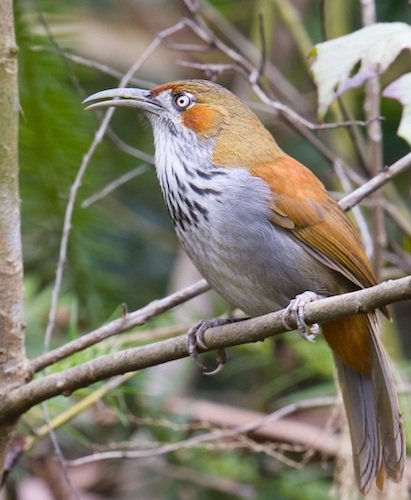Jiangxi Province

Birding Jiangxi
Jiangxi is a southern province of the People’s Republic of China, spanning from the banks of the Yangtze River in the north into hillier areas in the south.The name of the province does not mean ‘west of the Yangtze’ as a literal reading would imply, but originated as a contraction of ‘Jiangnan Xi’, ‘West Jiangnan’, or more literally ‘the west of the south of the Yangtze’. The name was coined when Jiangnan (‘south of the Yangtze’) Circuit was split into western and eastern halves during the Tang Dynasty. The short name for Jiangxi is ‘Gan’, for the Gan River.Jiangxi borders Anhui to the north, Zhejiang to the northeast, Fujian to the east, Guangdong to the south, Hunan to the west, and Hubei to the northwest. The provincial capital of Jiangxi is Nanchang.Mountains surround Jiangxi on three sides, with the Mufu Mountains, Jiuling Mountains, and Luoxiao Mountains on the west; Huaiyu Mountains and Wuyi Mountains on the east; and the Jiulian Mountains and Dayu Mountains in the south. The southern half of the province is hilly with ranges and valleys interspersed; while the northern half is flatter and lower in altitude. The highest point in Jiangxi is Mount Huanggang in the Wuyi Mountains, on the border with Fujian. It has an altitude of 2157 m.The Gan River dominates the province, flowing through its entire length from south to north. It enters Lake Poyang in the north, the largest freshwater lake of China; that lake in turn empties into the Yangtze River, which forms part of the northern border of Jiangxi. Important reservoirs include the Xiushui Tuolin Reservoir in the northwest of the province on the Xiushui River, and the Wan’an Reservoir in the upper section of the Gan.Jiangxi’s climate is subtropical. Average temperatures are about 3 to 9°C in January and 27 to 31°C in July. Annual precipitation is 1200 to 1900 mm.
-
NNR Poyang Lake
InformationSatellite ViewPoyang Hu is a huge area of flooded land north of the city of Nanchang. A wintering ground for tens of thousands of duck, geese and cranes. Probably the best and most reliable site in the world for Siberian Crane, with Hooded, White-naped and Red-crowned as a supporting cast. Also great for Oriental Stork, Black-faced Spoonbill and Swan Goose. Mid-November through to early March. (Fog can be a real problem!)
-
Wikipedia
GNU Free Documentation License
http://en.wikipedia.org/wiki/Jiangxi
-
Number of bird species: 503
(As at August 2018)
-
Birding South East China
By Tim J Woodward | Tim Woodward | 2006 Paperback | 423 pages, 88 colour photos, 160 maps | ISBN: 9628508423 Buy this book from NHBS.com -
The Birds of Hong Kong and South China
By Clive Viney, Karen Phillips & Lam Chiu Ying | Hong Kong Government Information Service | 2005 | Paperback | 255 pages, 91 colour plates, b/w illus, 4 maps | ISBN: 9620204042 Buy this book from NHBS.com
-
NNR Jinggang
InformationSatellite ViewThe range's massif consists of a number of thickly forested parallel ridges. On the heights there is not much farmland with most settlements at the base of the mountains. -
NNR Lushan
InformationSatellite ViewLocated in the south of Jiujiang City, north of Jiangxi Province, Lushan Nature Reserve covers a total area of 30,466 hectares. The highest peak of Lushan Mountain is 1,474 meters above sea level. Its main protection targets are forest ecosystem, cultural heritages, glacier features and natural landscape. More than 40 species of plants found here are either rare or local special species including Katsura tree, Manglietia fordiana, Chinese tulip and eucommia. Animals under the state protection are leopard, giant salamander, civet, python, pangolin, Hydropotes inermis, muntjac, silver pheasant, white crane, mandarin duck and so on. In addition, there are 26 ancient glacier heritages such as cirque, icehouse and deep valleys. In December1996, the Lushan Reserve was listed as World Nature Heritage. -
NNR Poyang Lake
InformationSatellite ViewThere is an integrated wetland ecosystem structure in the reserve and the biodiversity is abundant, with 45 species of mammals, 310 species of birds, 48 species of reptiles, 136 species of fish, 227 species of insects, etc. The highest number of the Siberian Cranes wintering in the reserve is more than 4,000, accounting for 98 % of the global number. And more than 80 % of the global Oriental White Storks and 70 % of the global White-naped Cranes winter in the reserve. It is also the wintering site for the largest population of the Swan Geese in the world (the highest number is more than 60,000) and the Tundra Swans in China (the highest number is more than 80,000). Meanwhile, it is important flyway and stopover site for a large number of rare and endangered migrants. -
NNR Wuyishan
InformationSatellite ViewThe Wuyi Mountain stretches for thousands of miles like a green dragon all the way across the provinces of Fujian, Zhejiang, Jiangxi and Guangdong. The world-famous Wuyishan National Key Nature Reserve just sits on the highest section on the north of the Mountains. It is the single biggest and the most comprehensive surviving semi-subtropical forest system in the south-east mainland China. It is within the World biosphere Protection Network of the United Nations and is ranked Class-A global nature reserve…
-
Alpine Birding
Tour OperatorBirding trips here are made for avid birders including yearly-run trips and new China birding trips developed by AlpineBirding team and guided by our bird experts in the best -
China Birding Tour
Tour Operator
-
2013 [01 January] - Jeff Hopkins - Poyang Hu
PDF Report…When the fog started to lift, the cranes were distant. But with a scope we could clearly make out many white-naped cranes, along with large flocks of taiga bean geese (probably taigas, anyway). While scoping the cranes, a small flock of oriental white storks flew over and landed in the fog. As the fog continued to lift, we found a close Chinese grey shrike that flitted around from stalk to stalk… -
2013 [02 February] - Jeremy Mark Hurley - Nanchang
ReportList -
2017 [06 June] - T Devaram - An early Summer Splash in Wuyuan, Jiangxi
ReportMy previous visit to Wuyuan was couple of years ago but that was almost a total wash out due to constant downpour and wet camera(Thanks to the rain again). My first trip in 2012 was fantastic, despite being sick for the most part of the tour and have to put up with the “American Company” and his nanny. So, this trip is to relive the 2012 trip planned by Mark Maddock with few extra stuff by visiting the border of Zhejiang province and some cultural visits. -
2017 [12 December] - Oscar Campbell & Mark Smiles
PDF Report...Birdingsites visited were the Wuyuanarea(2 days), Emei Fengmountain (3 days)and Po YangLake(3 days); we also spent a few days being tourists at Huangzhoucityand Huangshan(Yellow Mountain) and fitted in a little bitof Shanghaibirding(1 ½ days)at either end... -
2018 [03 March] - Mike May
PDF ReportOur purpose was to visit Poyang Lake to see wintering Cranes and combine that with another lifelong dream of seeing pheasants in the wild. For the latter, Sichuan is a diversity hotspot holding 25 of the 63 species of Phasianidae recorded in China, where our main targets were Lady Amherst’s and Golden Pheasants. As preparations for the trip proceeded, we added an extension to Taiwan to include their own very special endemic Pheasants...


